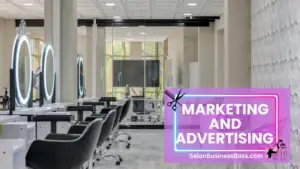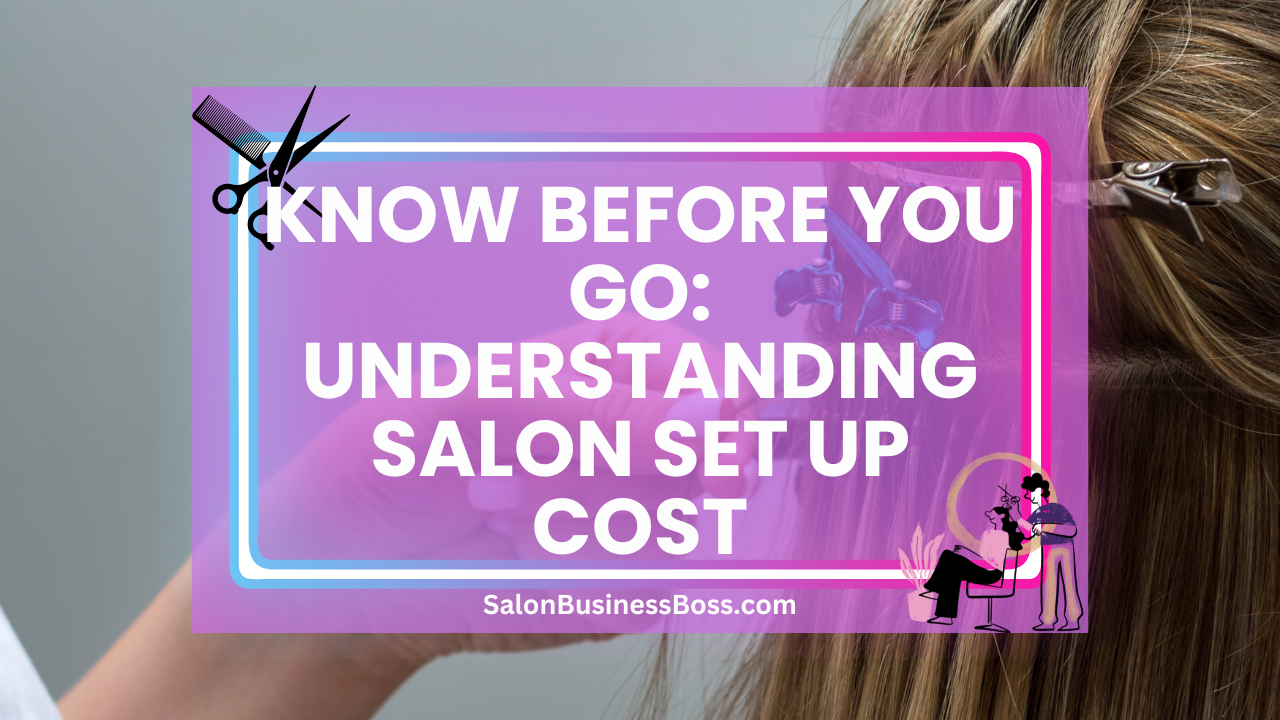Setting up a salon can be a dream come true for many aspiring entrepreneurs in the beauty industry. However, before diving into this venture, it is crucial to understand the various costs involved. From renting a suitable space to purchasing equipment and supplies, the initial investment can vary significantly based on the size and scope of your salon.
Setting up a salon incurs annual expenses ranging from $550 to $2,300. Rent, utilities, equipment, supplies, staff wages, marketing, insurance, and permits contribute to this cost.
1. Rent and Utilities

The location of a salon is a critical factor that can greatly influence the financial aspects of the business. Prime spots in bustling areas, such as busy shopping districts or popular city centers, often come with higher rental costs due to their increased foot traffic and visibility. These locations might offer excellent exposure and attract a larger customer base, but they can be financially demanding for new or small-scale salon owners.
On the other hand, less crowded or suburban areas may provide more affordable rental options, enabling salon owners to reduce overhead costs. While these locations might have lower visibility and foot traffic, they can still attract loyal clientele through strategic marketing efforts.
On average, salon owners can expect to spend between $400 to $1,500 per month on rent, depending on the chosen location and the size of the salon. Additionally, utilities such as electricity, water, and internet are ongoing expenses that must be factored into the budget. These utilities usually amount to an extra $50 to $200 per month.
When considering the annual cost, salon owners can expect to pay between $6,000 to $18,000 for rent and utilities, based on the location and size of the salon. Careful consideration and financial planning are essential to strike the right balance between the location’s benefits and the associated expenses. Assessing the target market, competition, and potential return on investment can help salon owners make informed decisions regarding their salon’s location, ensuring long-term financial sustainability and success.
Read more about: Hair Salon Insurance Cost: Factors, Coverage, and Implications
2. Salon Furniture and Equipment
Equipping a salon with essential furniture and equipment is a crucial investment that directly impacts the quality of services provided and the overall customer experience. The list of necessary items includes styling chairs, shampoo stations, hairdryers, manicure tables, and various other pieces of equipment specific to the salon’s services. The cost of furniture and equipment can vary significantly based on factors such as the quality of materials, brand reputation, and technological features.
For salon owners with budget constraints, a viable option is purchasing second-hand equipment. This can be a cost-effective approach that allows for significant savings while still maintaining the necessary functionality. However, it is essential to ensure that the used items are in good condition and meet safety standards.
On average, salon owners can expect to spend approximately $2,000 to $5,000 initially to furnish their salon with the essential equipment. This cost can be higher for larger or high-end salons that require more specialized equipment. Additionally, it is prudent to set aside an annual budget of $500 to $1,000 for equipment replacements and upgrades. Regular maintenance and upgrades are essential to ensure the salon’s facilities remain up-to-date and in excellent working condition, contributing to a positive customer experience and repeat business.
Investing wisely in furniture and equipment can lead to long-term cost savings, as higher-quality items are likely to last longer and require fewer replacements. Careful research, comparing prices, and considering customer reviews can assist salon owners in making informed decisions and striking the right balance between quality and budget considerations. Ultimately, well-chosen furniture and equipment play a pivotal role in creating a welcoming and professional salon environment, elevating the overall reputation and success of the business.
3. Salon Supplies and Products
Maintaining a well-stocked inventory of hair care products, nail polishes, and skincare items is essential for any salon aiming to deliver top-notch services to its clients. The quality of products used directly affects customer satisfaction and loyalty. The cost of salon supplies can vary significantly based on the brands and product lines chosen, as well as the scope of services offered.
The selection of reputable, high-quality brands will naturally result in higher costs, but it also reflects positively on the salon’s image and the efficacy of the services provided. Conversely, opting for more budget-friendly products can help reduce expenses, but it is crucial to strike a balance between cost and quality to maintain customer satisfaction.
On average, salon owners can anticipate spending between $200 to $500 per month on supplies. This range is influenced by the size of the salon, the range of services offered, and the frequency of product usage. Annually, this translates to a cost of approximately $2,400 to $6,000.
To optimize supply expenses, salon owners can consider bulk purchasing options and negotiate favorable deals with suppliers. Regularly monitoring product usage and avoiding wastage can also contribute to cost savings. Moreover, staying updated on the latest trends in the beauty industry can help identify popular and in-demand products that resonate with clients.
Efficient management of salon supplies not only ensures seamless operations but also enhances the overall customer experience. With a well-curated range of high-quality products, the salon can build a loyal client base and establish a reputation for excellence, paving the way for long-term success in the competitive beauty and wellness industry.
4. Staffing and Wages
Hiring employees is a significant step for any salon owner looking to expand their business and provide a broader range of services. However, it also introduces additional costs that must be factored into the salon’s annual budget. Staff wages and benefits are among the most critical expenses, and their magnitude depends on various factors.
The number of staff members employed directly influences the overall cost of wages. A smaller salon with a limited number of employees might have lower wage expenses compared to a larger establishment with a more extensive team. Additionally, the experience level of the staff plays a crucial role in determining wages. Highly experienced and skilled employees may command higher salaries, while entry-level positions typically come with more moderate wage requirements.
Beyond wages, employers must also account for payroll taxes and benefits as part of the annual expenses. Payroll taxes include various taxes deducted from employees’ wages, such as Social Security and Medicare taxes. Benefits, such as health insurance, paid time off, and retirement contributions, are crucial for attracting and retaining qualified staff. These costs can add up significantly and contribute to the overall annual expenditure.
A salon owner might allocate between $15,000 to $30,000 annually for staff wages, payroll taxes, and benefits. This range considers factors like the salon’s size, the number and experience level of employees, and the benefits offered. The wages and benefits package must be competitive to attract skilled and dedicated employees, as they are integral to delivering exceptional services and maintaining a positive salon reputation.
To optimize labor costs, salon owners can consider various strategies. Proper staffing management, including creating efficient schedules and optimizing employee utilization, can lead to cost savings. Moreover, providing training and opportunities for professional growth can enhance employee retention, reducing recruitment and onboarding costs over time.
Incorporating employees into the salon business requires thoughtful financial planning. Staff wages, payroll taxes, and benefits constitute significant annual expenses that contribute to the overall financial health of the salon. By striking the right balance between competitive compensation and cost efficiency, salon owners can create a motivated and skilled team that drives success and fosters a positive work environment.
5. Marketing and Advertising

Effective marketing and advertising are essential for any salon to thrive in a competitive beauty industry. To attract and retain customers, salon owners must strategically allocate resources to various marketing channels. These expenses can encompass a wide range of activities, including social media promotions, printed materials, website maintenance, and other promotional initiatives.
In today’s digital age, social media has emerged as a powerful tool for connecting with potential clients. Utilizing platforms like Instagram, Facebook, and Twitter allows salons to showcase their work, engage with customers, and build an online community. While social media can be cost-effective, dedicating some budget for sponsored posts or targeted advertising can significantly enhance a salon’s reach and visibility.
Printed materials, such as business cards, flyers, and brochures, remain relevant and effective in attracting local customers. Investing in high-quality printed materials that showcase the salon’s services and offers can make a lasting impression on potential clients.
Maintaining a well-designed and user-friendly website is crucial in today’s digital landscape. A website serves as a virtual storefront, providing valuable information about the salon’s services, pricing, and contact details. Regular website maintenance, including updates and improvements, ensures a positive online presence and helps potential customers find the salon more easily through search engines.
The monthly budget for marketing and advertising can vary based on the salon’s size and goals. Allocating between $50 to $200 per month is a reasonable range for many salons. Annually, this amounts to approximately $600 to $2,400. This budget allows for consistent efforts across different marketing channels, providing a holistic approach to attract and engage with customers.
To maximize the return on marketing investments, salon owners should track the performance of different marketing strategies. Monitoring social media engagement, website traffic, and customer inquiries can help identify the most effective channels. Feedback from customers and analyzing customer acquisition costs can further guide marketing decisions.
Read more about: How to Open a Hair Salon: From Vision to Grand Opening
6. Insurance and Permits
Securing the appropriate insurances and permits is essential for safeguarding a salon business and ensuring compliance with local laws and regulations. These protective measures provide financial security and legal protection against potential liabilities that may arise during salon operations.
General liability insurance covers accidents or injuries that may occur on the salon premises. It protects the salon owner from legal claims and medical expenses if a customer or visitor is injured while at the salon. Similarly, professional liability insurance, also known as malpractice or errors and omissions insurance, offers coverage in case of claims related to unsatisfactory services provided by salon staff. This type of insurance is particularly crucial for salons offering specialized services like hair treatments or skincare procedures.
In addition to insurance, obtaining the necessary salon operation permits is vital to comply with local regulations. These permits vary depending on the location and may include health permits, business licenses, and zoning permits. Salon operation permits demonstrate that the salon meets health and safety standards and has met all legal requirements to operate in the area.
The annual cost of insurance and permits can range from $300 to $800, depending on factors such as the salon’s location, size, and the coverage level of the insurances. These costs are a small price to pay compared to the potential financial consequences of unforeseen accidents or legal issues.
By obtaining the appropriate insurances and permits, salon owners can focus on their core business without worrying about potential risks and legal liabilities. It provides peace of mind and a strong foundation for building a reputable and successful salon business. Consulting with insurance professionals and local authorities can help salon owners identify the specific requirements and tailor their insurance and permit choices accordingly. Taking proactive measures to protect the salon business sets the stage for sustainable growth and long-term success in the beauty industry.
Conclusion
Setting up a salon involves careful planning and financial consideration. While the initial investment may seem daunting, breaking down the costs into annual expenses can help salon owners budget and plan more effectively. The annual cost for running a salon can vary significantly, ranging from $550 to $2,300, depending on factors such as location, size, and the range of services offered. By understanding and preparing for these expenses, aspiring salon owners can embark on their journey with confidence and create a thriving and successful beauty business.
Frequently Asked Questions

1 .Is it possible to start a salon with a smaller budget?
Yes, it is possible to start a salon with a smaller budget by making strategic choices in location, equipment, and marketing expenses.
2. What should I prioritize when budgeting for my salon setup?
Prioritize essential items such as salon chairs, styling stations, and basic supplies. Consider additional items as your salon grows.
3. Can I lease salon equipment instead of purchasing it outright?
Yes, equipment leasing is an option to spread out costs over time. However, compare leasing costs with outright purchases to make an informed decision.
To learn more on how to start you own salon checkout my startup documents here.
Please note that the contents of this blog are for informational and entertainment purposes only and should not be construed as legal advice. Any action taken based on the information provided in this blog is solely at your own risk. Additionally, all images used in this blog are generated under the CC0 license of Creative Commons, which means they are free to use for any purpose without attribution.

About the author. Entrepreneur and Salon Business Fan.
Hi! I am Shawn and I am a happy individual who happens to be an entrepreneur. I have owned several types of businesses in my life from a coffee shop to an import and export business to an online review business plus a few more and now I create online salon business resources for those interested in starting new ventures. It’s demanding work but I love it. I do it for those passionate about their business and their goals. That’s why when I meet a salon business owner, I see myself. I know how hard the struggle is to retain clients, find good employees and keep the business growing all while trying to stay competitive.
That’s why I created Salon Business Boss: I want to help salon business owners like you build a thriving business that brings you endless joy and supports your ideal lifestyle.

